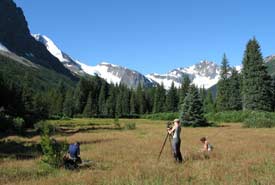The last places on Earth: Protecting globally rare habitats in Canada (Part one)
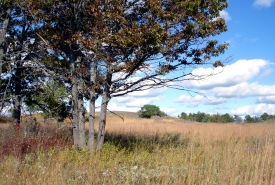
Black oaks on the prairie and savannah, Rice Lake Plains, Ontario (Photo by NCC)
The Rice Lake Plains in Ontario, Roberts Island in Nova Scotia and King Ranch in Alberta all have something incredibly important in common: They are places that the Nature Conservancy of Canada (NCC) is working to protect. Each property provides habitat for nationally rare species, each is building on a network of protected areas and conservation lands and each provides important ecological services to local communities, such as water purification and flood control.
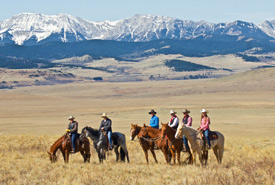
Waldron shareholders at King Ranch, AB (Photo by Karol Dabbs)
But they also have a significance that extends beyond local communities, provincial boundaries and even Canada. They’re all places where you can find habitats, or what scientists call ecosystems, that are globally rare. These are among the few places on Earth where black oak savannah, Atlantic coastal plains flora and fescue grassland can be found.
Globally rare habitats often have small natural ranges or are so heavily impacted by human activities that only a few small fragments remain. They are often declining in size and condition, and many could be lost in a generation without heightened awareness and focused attention. One of the conservation challenges we face in Canada is that some of these ecosystems may be slipping away before their conservation significance is recognized. We may be losing them before we have time to act.
Designating the need for conservation
The word ecosystem originates from the Greek words oikos, meaning “home,” and systema, meaning “organized whole.” Today, we use the word ecosystem to categorize broad assemblages of plants and animals that live together in a community as well as their physical environment, such as water, soil and climate.
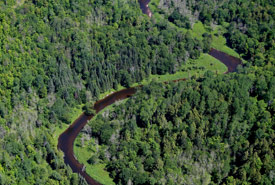
Kenauk, QC (Photo by Mike Dembeck)
Just like we classify species into smaller groups (e.g. animal – mammal – carnivore – canine – wolf – grey wolf), we can classify ecosystems using a similar hierarchical approach. For example, most of NCC’s Kenauk project in Quebec is forest, but this forest can be further classified into finer ecological systems. Some forests on this property are deciduous, others coniferous and some have a have a mix of both.
A mixed forest could be further classified into ecological associations (or vegetation communities) based on the tree species. It could be a sugar maple-beech-hemlock forest, or it could be an eastern white cedar-trembling aspen forest. Once we’re able to get the classification down to a vegetation community, we can better compare it to similar forests and understand how common or rare it is across the landscape.
Today, the best tool we have for identifying globally rare ecological associations in Canada is through NatureServe. The NatureServe network links Conservation Data Centres throughout Canada, the U.S., Mexico and Central America. The network ensures we have a consistent taxonomy for species and develops status ranks at the provincial, national and global levels. For species, these status ranks are based on criteria such as range, population trends and threats. NatureServe also applies similar criteria to assess the conservation status of ecological associations.
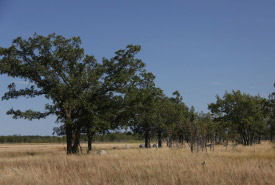
Tall grass prairie, Manitoba (Photo by NCC)
One of the biggest gaps in our ecological knowledge in Canada is that we haven’t described and catalogued all of the different ecological associations, and, as a result, we don’t know their conservation status. While some are well documented and are clearly of national and global conservation concern, such as alvars, tall grass prairie and Garry oak savannah, for many others we simply don’t know their full conservation status.
The last and best examples of these vegetation communities may be right under our noses, but we simply may not know it. For example, barrens dominated by broom crowberry are known to inhabit both sandy plains and bedrock in Nova Scotia, including the Annapolis heathlands and NCC’s current project at William’s Lake. This ecological association has been described provincially, and we know it has a very limited distribution in Nova Scotia. What we don’t know is its broader distribution and status in North America, particularly along the U.S. eastern seaboard. In this case, we are probably dealing with an ecological association that is not only rare provincially, but of global conservation concern.
Seeking out and protecting rare natural spaces
Focused protection of rare ecological associations helps to maximize our conservation return on investment. These are places where many conservation goals can often be achieved at once. It’s a pretty good conservation deal when you can protect a property, such as NCC’s Wideview Complex in Saskatchewan, that has 10 national species at risk and wetlands that provide habitat for waterfowl, and which protects a globally rare grassland community. It’s the type of conservation we need to do more of in Canada.
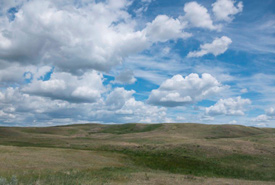
Taking in the view at Wideview, SK (Photo by Bill Armstrong)
The identification and systematic conservation of ecosystems is still in its infancy and is decades behind species conservation efforts. The good news is that we can make up for lost ground quickly. Tools such as NatureServe ecological association status rankings allow scientists to better assess the conservation needs of vegetation communities. Current efforts to complete the Canadian National Vegetation Classification System and integrate it with the U.S. system will help us better understand the range and distribution of ecosystems and, ultimately, the habitats that we need to protect and restore.
We can even take this a step further, as there is a global list of threatened ecosystems that is managed by the International Union for Conservation of Nature (IUCN). The IUCN Red List of Threatened Species has been guiding global conservation efforts for more than 50 years, but the global list of threatened ecosystems is relatively new in comparison. For more information on the IUCN Red List of ecosystems, stay tuned for part two of this series, where we talk with Rebecca Miller, program manager of IUCN ecosystem management.
This blog was written collaboratively by NCC's Dan Kraus, senior conservation biologist, and Josh Noseworthy, director of conservation science for NCC's Atlantic Region.

